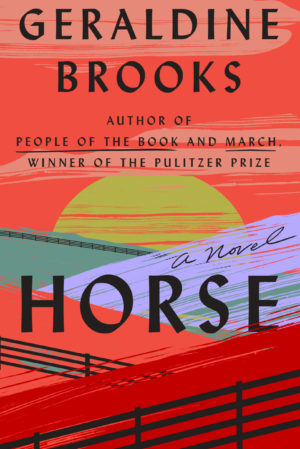Horse
by Geraldine Brooks
reviewed by Bailey Sincox
“Historical fiction” may be one name for Geraldine Brooks’s craft, but that label doesn’t do her novels justice. Her Pulitzer Prize-winner, March (2005), spotlights the taciturn father from Little Women. A transcendentalist compelled to enter the Union Army, he is a man of ideas struggling to become a man of action. People of the Book (2008) follows a Jewish manuscript from medieval Spain to modern Bosnia through exile, conflict, and genocide. Brooks’s novels don’t just use history as backdrop; they plumb the depths of the past in search of wisdom for the present.
Horse brings together the best parts of Brooks’s earlier work. It combines March’s focus on the American Civil War with People of the Book’s multiple narrators. Like March, Horse focuses on a character, while also centering on objects, like People of the Book.
The title refers to the label on a skeleton gathering dust in the Smithsonian’s attic. As it turns out, “Horse” is as much of a misnomer for Lexington, called “the greatest thoroughbred stud sire in racing history,” as “historical fiction” is for Horse. In Washington, D.C. in 2019, Jess, a zoologist, is called to restore Lexington’s newly-identified bones for public display. She collaborates with Theo, an art historian, who finds a painting of a horse in his neighbor’s garbage. This is the premise for Brooks’s latest transhistorical, when-worlds-collide plot.
Jess and Theo’s stories are interspersed with that of Jarret, Lexington’s groom, during the 1850s and 60s. Born into slavery in Kentucky, Jarret bonds with a colt called Lexington, setting out to prove that “all men are equal on the turf or under it” and hoping to win enough at the races to purchase his freedom. Lexington grows famous for his speed and endurance under Jarret’s care, but, by 1854, “the enmity is grown so great that even the turf provides no neutral ground.” Sold, along with Lexington, first to a New Orleans entrepreneur, then back to Kentucky, Jarret watches the Civil War unfold from the South’s elite stables. In 2019, Jess and Theo know nothing about Jarret. Nevertheless, they use the evidence they have to reconstruct his world.
In Horse, Brooks examines what others have overlooked. Like Horse’s protagonists, she rummages through what looks like junk, searching for treasure. Jess rescues Lexington’s bones and “articulates” them; Theo salvages the painting to restore it. These objects carry traces of the past that need to be studied in order to be understood—and in order for their full stories to be told.
Part Da Vinci Code and part Nickel Boys, Horse draws readers into a historical mystery: what made Lexington so great? If he was so great, why was he forgotten? (Seabiscuit gets a shoutout, too.) In its search for answers, the novel wavers between awe and indignation. While many of the novel’s characters are historical figures (abolitionist Cassius Clay, art dealer Martha Jackson, Lexington himself), Jarret is just a figure in a painting—the painting of Lexington “led by Black Jarret, his groom” recorded in an artist’s catalogue. A painting that’s now lost.
At the novel’s heart, then, is a more important question: how did we forget about Jarret? The bitter fact of knowing more about the horse than the man is not lost on Brooks. She elevates the history of Black grooms, trainers, and jockeys even as she underscores the disturbing interchangeability of the men with the horses they rode. When the New Orleans horse racing impresario Ten Broek says “this [ … ] is my Jarret. He knows the horse. Follow his advice in every particular, as if his instructions were my own,” Jarret “trie[s] to ignore the dissonant clanging of Ten Broeck’s words. My horse. My Jarret. New grandstands, new barns—did the man just buy up everything he wanted in this world?” This is Horse’s strength: it depicts dignity and indignity at once. It asks readers to remember the passion and expertise Black men brought to the sport of horse racing and to recognize the violence that kept them out of its official record. As the novel shows, the horse whose legacy is preserved in museums, art galleries, and stud catalogues would not exist if not for the man whose life is irrecoverable except through fiction.
Horse may be better on the past than the present. The novel’s attempts to depict the Black Lives Matter movement and other current events can be clunky. But its spirit of humility and humanity prevails. Words directed at a collector buying Lexington’s painting may as well be directed at Brooks: “I guess you like horses.” Like her, Brooks responds: “It’s far more complicated than that.” Horse shows us just how complicated it is.
Published on September 6, 2022

